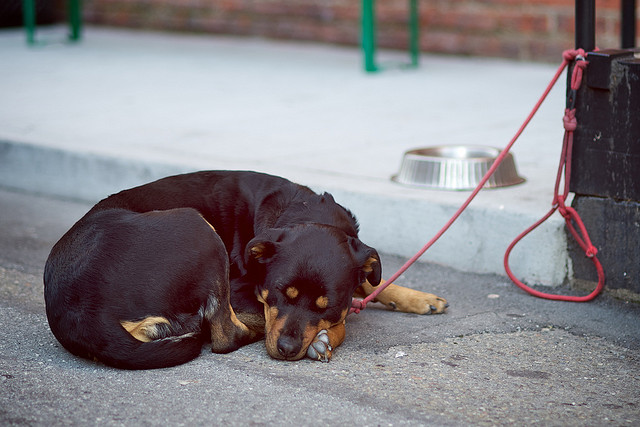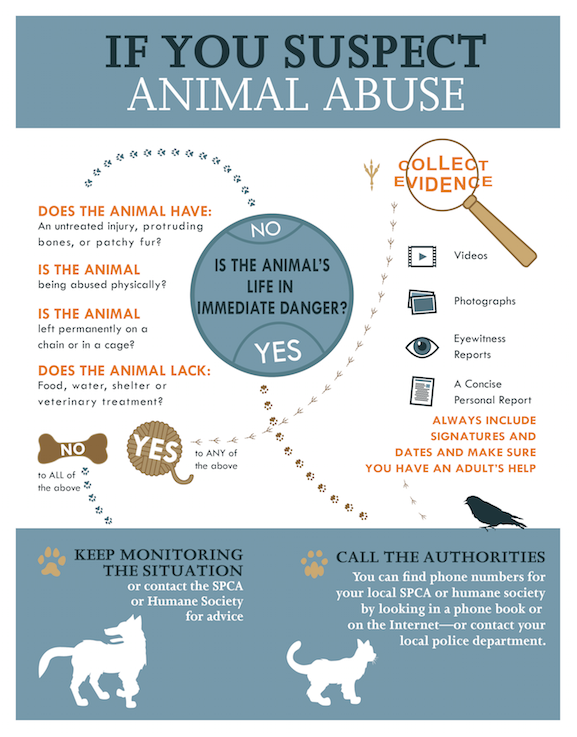
When was the last time you heard of anyone turning him- or herself in for animal abuse? It just doesn’t happen often, if at all.
It’s a fact that most animal abuse is never reported. Another fact? The abuse of pets and animal companions is a frequent occurrence in the United States, an occurrence we’re reminded of daily through Facebook timeline posts and celebrity-laden commercials pleading to end animal cruelty.
A few facts about animal abuse:
- In the United States, 550 animal abuse cases were reported in 2012, including neglect, shooting, stabbing, fighting, beating, mutilation, torture, strangulation, burning and poisoning.
- Many animals suffer multiple forms of abuse, with the most common type of abuse being neglect and abandonment.
- Dogs and cats are the most common victims, but abuse happens among other animal species, including domestic farm animals, wild animals, small pets and all manner of bird and fowl.
These statistics represent only a fraction of the animal abuse being committed every year — and because abusers aren’t turning themselves in, it falls on the general public and animal lovers to learn how to recognize the signs of abuse and what to do about suspected animal cruelty.
Types of Animal Abuse and Common Warning Signs
All animal cruelty cases are separated into three categories: unintentional, intentional and cruel intent. Once you learn to recognize the warning signs of animal abuse, you’ll be better equipped to report it.
It may be hard to believe, but many people don’t even know that the harm they are inflicting on their pets is in fact abuse. This type of abuse is known as unintentional, and it’s caused through neglect, animal hoarding or failing to meet an animal’s basic needs.
Intentional animal abuse and cruel intent both refer to abuse that is performed with the knowledge that an animal is being harmed and possibly injured.
Cruel intent is often recurring, and abusers in this category feel a sense of power, control or enjoyment when inflicting pain on others.
This video discusses the differences between animal collecting and hoarding:

18 Signs of Animal Cruelty
Below are common signs to look out for if you suspect animal abuse or cruelty:
- Offensive odors coming from a home or yard, such as the constant smell of ammonia or feces
- Animals are not given basic care and protection, such as shelter, food, water, humane care and medical treatment, as required by law
- Animals are infested with fleas, ticks or parasites
- Animals are injured and show no sign of medical treatment
- Animals have open wounds or sores
- Animals show hair loss, lesions, scabs or other skin conditions that have not been treated
- Animals have been tied up without access to fresh water or food
- Animals are kept confined inside a car, garage, basement, attic or other enclosed area during extremely hot or cold weather
- Animals are emaciated and shows signs of malnutrition
- Animals are hostile, aggressive, ill, distressed or exhibit other signs of inadequate socialization
- Animals are kept in overcrowded, deteriorated or unsanitary conditions
- Animals are kept inside cages or kennels that are too small and are rarely let out
- Individuals are seen striking or causing physical harm to an animal
- Individuals are seen abandoning an animal
- Individual has a large number of animals in his/her care and may not even know the total number when questioned
- Injuries on an animal’s body show sign of infection or disease, including maggots or flies
- Death of one or more animals under suspicious conditions
- Collar has become embedded into the skin of an animal

The above conditions by themselves do not necessarily mean that an animal is being abused, and it’s important to examine the entire situation before jumping to conclusions.
For example, you might notice that your neighbor’s three cats are infested with fleas and are physically uncomfortable.
After a short conversation with your neighbor, you learn that all three cats are being treated, and they appear healthy and socially adjusted. You conclude that these cats are probably not being abused.
On the other hand, you notice another neighborhood dog with an obvious flea infestation who also looks emaciated, has open sores on its body, and acts aggressively when approached. In this case, you may have reason to suspect abuse.
One important note: Do not approach an aggressive owner with accusations of animal abuse. Instead, notify authorities and allow them to handle the case.

Be a Hero
Pets have no voice to cry out for help. They aren’t able to alert authorities to abuse, and they can’t quietly discuss their pain and injuries with a veterinarian.
You have to be the eyes and ears for the animals you encounter to ensure that if there is any abuse, it can be stopped in time before serious injury or death occurs.
To report animal cruelty, notify local law enforcement or your state’s local humane, animal control or animal shelter organizations immediately. Be prepared to provide them with dates, locations and specific instances of abuse so that any animals in danger can be rescued immediately.

Your Turn to Talk
Have you ever witnessed or reported animal abuse? What are your thoughts on your state’s current animal abuse laws? Tell us in the comments below!


